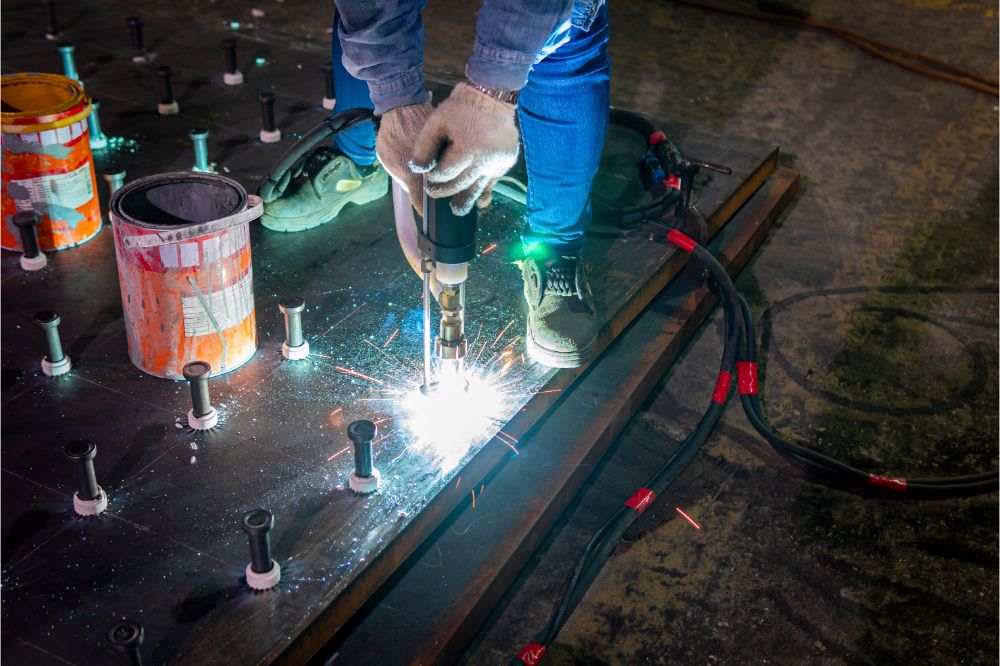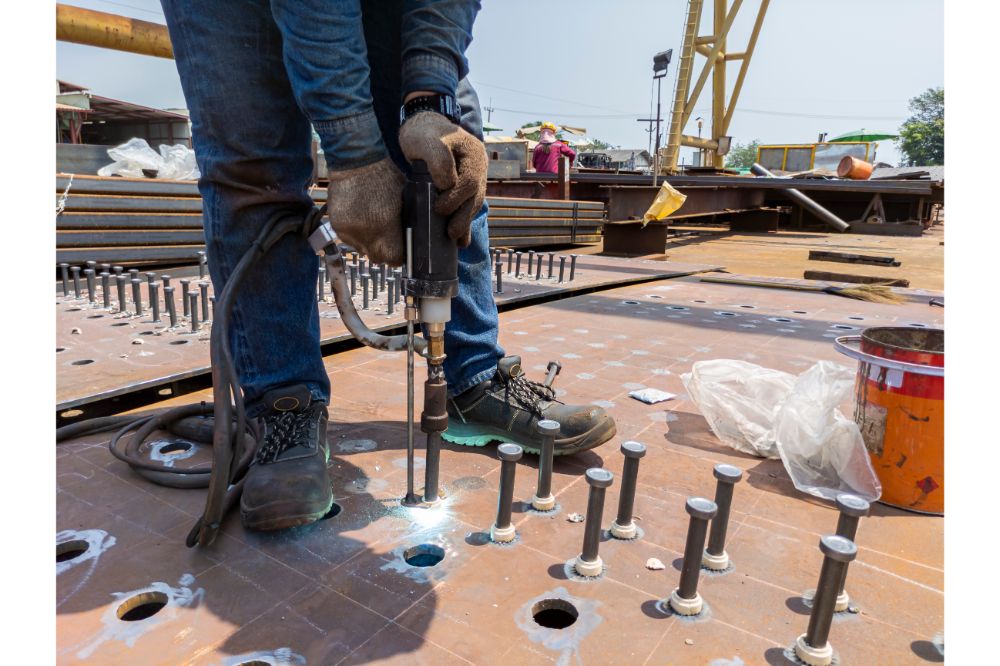Metal clasps are welded to other metal components by heating them with an arc of electricity. Manufacturing, construction, and engineering professionals use it among a variety of welding techniques. There are still many out there that don’t know what stud welding is. It’s easy to understand and simple to use once you know how.
As a result of its precision, efficiency, and pace, stud welding is preferred by many. This article will take a closer look at stud welding.
What Is Stud Welding?
It is a single-sided fastening method involving joining a metal stud to a second metal component, in most cases a metal sheet. You do this with a stud welding gun. A positive electric current creates a strong arc of electricity that fuses parts.
Both metals melt at their melting points when the arc generates enough heat. Upon forming a molten material pool, it is pressed together with its parent material to create a secure joining.
The speed at which stud welding can be done makes it popular. Using the correct equipment, stud welds can be completed in a few seconds. Although you get a shorter weld time, it does not affect the joint’s maximum weld strength and durability. Their strength is greater than that of the parent material once they have been created, and their life expectancy is indefinite.
Stud Welding’s Benefits
Easily Accessible
A stud weld allows workers to make an effective weld without straining themselves. It is only necessary for them to have access to one side. Making maneuvers easier is made possible with easier equipment. For example, welders can access hard-to-reach areas using thinner welding tools.
Amount of Speed
In comparison to other fastening techniques, stud welding is remarkably fast. The process can be sped up for large-scale stud welding by purchasing powerful equipment. For example, there is a stud welding machine capable of producing stud welds at a speed of eight per minute. It is also possible to completely or partially automate the process to produce up to 60 stud welds every minute.
Holes Are Not Present
A stud is fused to a metal sheet without making holes, so the metal sheet does not need to be cleaned or finished. Consequently, there is no risk of the sheet leaking or weakening. Welds without leaks also prevent corrosion, ensuring durability and cleanliness.
Capable of Adapting
Many metals and stud welder sizes can be used for stud welding. Stainless steel, aluminum, mild steel, copper, and brass are all suitable for stud welding if the appropriate equipment is used. You can get a range of stud welding threaded, unthreaded, or internally threaded studs, and their diameters range from 1 to 25 mm, provided you have the correct equipment and attachments.
Visual Appearance
There is a strong preference for stud welding due to its largely “undetectable” effect. In this case, the parent material is fastened on only one side. Reverse side marks are minimal. The welding method is recommended when the goal is to obtain a fastening that is aesthetically pleasing while still strong.

Stud Welding Types
The Capacitor-Discharge Welding Process (CD)
The most commonly used metal welding stud technique is capacitor-discharge joining. Perfect for when near-perfect joints and minimal reverse tagging are required to achieve aesthetic results. This technique works extremely well on aluminum, mild steel, and stainless steel surfaces that are neat and flat.
Capacitor discharge welding is the best choice for dense parent materials, which operate with components no thicker than 0.7 mm. Compared to other processes, this is more strict about the stud diameter on which welding may be performed.
For efficient and reliable welding, narrower studs, for example, studs of 1 mm width, are essential.
Unlike welding the traditional way, this method has a limited range of motion. Therefore, welding with the drawn arc method is best suited for dusty, powdery, or twisted materials.
Capacitor discharge welding does not have the same sensitivity to imperfections compared to other welding methods, and it costs less and is quicker (which makes it popular).
The diameter and mass of studs and adjacent kin predetermine the voltage required for CD welding. Mounted to the base materials, the stud is attached by a welded plug, a metal plug at the base of the CD arc stud.
Consequently, an electric current is emitted through the metal sheet, and the stud gets hot, reaches its boiling point, and melts.
Arc weld studs can be produced using CD equipment that is lightweight, easy to operate, and will not take up much space. If you are choosing CD gear, many factors need to be considered, including its weight, how easy it is to use, how fast it can weld, how versatile it is, and the charging time. CD equipment selection can be affected by different factors according to the tasks to be carried out.
Welding With the Drawn Arc Method
The best process of stud welding is drawn arc welding for materials larger than 2mm. Fasteners with bigger diameters can be fitted with the developed arc form (from 3 to 25 mm).
The weld filet is extremely clean and regulated, providing good infiltration results. In addition, this method works with imperfect or curved materials, increasing its versatility.
To achieve these outcomes, however, 415-volt three-phase power is required. Certain operations are best served by CD.
Ceramic Ferrules are often used with the drawn arc method, i.e., molten metal pools protected by ceramic shields on either side of the iron studs. A new phase is added to the process as a result.
During the welding process, the operator draws an arc around the plate stud and sparks the starter arc, allowing the stud to rise to a predetermined height. During welding, the plate melts a pool of liquid at the weld end of the stud.
By chipping away at the ferrule, the corresponding filet is enclosed.
Broad-diameter stud welding is only possible with the drawn arc process and works well with a wide range of guns. Due to its incineration and interaction with pollutants, welds often use flux to keep the area safe from pollutants.
Conclusion
As a result of this information, it will be easier to make an informed decision about stud welding and how to choose the right process for the job you are undertaking. Before you start arc stud welding, ensure you have the right stud welding equipment to make the job easier.
Arc stud welding is the new revolution in welding. When it looks better and appears seamless without holes, plus has the benefit of being quicker to use, why wouldn’t you choose to use it?

